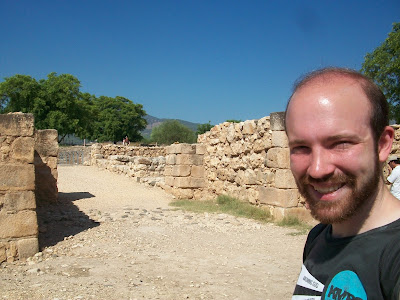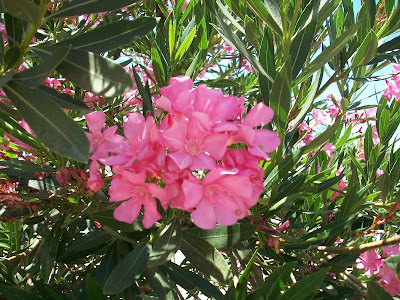 |
Walking to Hazor
|
Today we began with breakfast at the En-Gev Resort –
veggies and salads must be quite popular in Israel, though they did have a few cereal
and egg options as well. I guess this would be considered more of a
"Mediterranean Cuisine." We headed along the north shore of Galilee
up and over the north basaltic region to Hazor. This was the largest Canaanite
city in the late Bronze Age in its day it was the same size as Nineveh. Up the
mountain range of Moreh is where many of the Canaanites armies pulled together
go ambush Joshua, but Joshua "came on them suddenly" at Moreh and
utter destroyed them. He then proceeded back down to Hazor and burned the city.
This was the only other tel besides Jericho that Joshua burned. Inside the palace
or temple, one can see the cracked basalt stone from Joshua's fire. I talked to
an archeologist on the site and she showed me to the remaining visible burn
layer. The layer dates to late Bronze Age, more specifically to the 13th century. This would coincide with a late date for Joshua – however, at Jericho
we had evidence for an early date. I personally hold to an early date for the
exodus, so my first instinct is to say the archeology is a bit off. This will
be a subject that I will want to study into further. Solomon came through
later and fortified Hazor. This is the third city that where the Solomonic gate
is present. We have now seen each of Solomon's three gates: Gezer, Lachish, and
Hazor.
 |
Walls of Dan
|
Our next stop was at the ancient city of Dan. Today
the whole area is a natural reserve and rightly so. It is so green, wet and
beautiful. If I had been a Danite, I would want to move up here too. As it is
close to Mt. Hermon, there are many springs in the area. The largest spring in
the Middle East is located here. The spring puts out about twenty-two liters of
water per minute. Literally, a river runs forth from Dan. We began by hiking up
to the ancient Laish gate. This is the second oldest gate in the world with
3,800 years of history. To put it into perspective, this is roughly the time Abraham
would be traveling down from Haran. We then went down to the Omri and Ahab
gate. In the city gate is where most of the city's business would take place as
well as judgment from the city elders. The city elders literally acted as the
city's father. As this was the weakest point in the city's defenses, sometimes
a shrine to the city god would be set up here for protection. We then headed up
to the location of an ancient Israelite shrine. Although Jeroboam had built
alters from Bethel to Dan, this particular alter was from the Omri Dynasty.
We headed back out and over to Caesarea Philippi. It
was here that our Lord came with the disciples into the very heart of paganism.
Here he asked the question, "who do you say that I am?" Peter
answered, "You are the Christ, Son of the Living God." Why did Jesus
bring them way out here? Perhaps there were a few reasons. Jesus had to be
careful in how he claimed to be the Messiah. The people of Israel, and even the
disciples were expecting someone like Maccabaeus – a warrior to free them from
Rome. Had he pronounced himself messiah, the people would rally to fight and He
could have case on his hands. Here in the remote upper Golan, Jesus could get
alone with his disciples. Here too, his statement takes on new understanding.
"The gates of hell shall not prevail against it." What are the gates
of Hades? This gate is here in Caesarea Philippi. There once was a spring that
flowed from the main cave. In Roman mythology, this would be a gate to the underworld,
essentially "the gate of Hades." Today, all the pagan temples built
at the site have long gone, but the rock (and the church) still remain. We then
took a hike through the park to the other side, passing a few remains along the
way. We crisscrossed the river making it to the large falls at the end.
 |
Looking toward Mt. Hermon - Syria is to the right. (At Bental Cone in
the Upper Golan) |
Our next stop was to Bental
Cone, one of the dormant volcanoes in Upper Golan. At the top of the cone or mountain
was a deserted Israeli bunker from the 1967 war. From this high location, we
could overlook the Israeli-Syrian border. Somewhere in the valley would have
been the road to Damascus on which Saul encountered the living Lord. On the Israeli
side is Mount Herman. This is the probable location for the transfiguration. This
would have been within Jesus' style to find a remote place to get alone. The
traditional site is Mount Tabor, but this is in a public location in view of
the whole valley. Christian's in previous ages probably selected this location
as it is conveniently along the pilgrim's path. After the lecture, we had some
time to either explore or grab a cappuccino at the coffee shop and enjoy the
view for a few minutes. I explored the bunker with my flashlight and took in
the views from all sides. Afterward it was back to En-Gev for the night.
 |
| Good Morning, Sea of Galilee |
 |
| Walking to Breakfast |
 |
| Passing the Jordan River North of the Sea of Galilee |
 |
This Region North of the Sea of Galilee is covered in Basalt - not a good
way to travel on foot or by animal. |
 |
| The Solomonic Gates at Hazor in the Hula Basin |
 |
| Hiking up to Hazor Tower |
 |
| Overlook from Hazor tower (with the Israelites) |
 |
| Looking down into the valley below |
 |
| I've decided to join the Israelite Army |
 |
| Walking to the Canaanite Palace/Temple at Hazor |
 |
| Lecture in the Hazor Temple - burned by Joshua |
 |
| Looking out from the temple |
 |
| The fire by Joshua got so hot it cracked the Basalt foundation! |
 |
| Here's me in Solomon's Gate at Hazor |
 |
Here you can make out the burn layer - it was very thick in the temple when
it was excavated. The archaeologist (she personally has been excavating the
site since the 1990's) said it smelled so fresh when they uncovered it. |
 |
| The Waters flowing at Dan! |
 |
| Hiking up to the Ruins of Dan |
 |
Here is the ancient gate of Laish - dating in at 3,800 years. Dan conqured
the city and renamed it after themselves. |
 |
| Walking toward the City Gate built by the Omri/Ahab Dynasty |
 |
Those five stones up by the wall are "standing stones" or "rememberance
stones" - something like Jacob would have set up at Bethel when he
dreamed of the staircase to heaven. However with these five stones,
we're not sure what they were trying to remember ;) |
 |
| Looking toward an altar built for something just outside the city |
 |
| Walking through the city of Dan |
 |
Wow look at that alter! ... actually it wouldn't have been that big. You can
see the foundation within the metal frame toward the back right. The rise to
the right are the stairs leading up to it. |
 |
| Looking out in the general direction of Lebanon from Dan |
 |
Standing at the Northern end of the altar complex - you're looking in the
general direction of Lebanon. |
 |
| Hiking around Dan |
 |
| The Largest Spring in the Middle East - puts out 22 liters per minute |
 |
| There are springs everywhere! The water is flowing from the rocks! |
 |
| Walking over the springs :) |
 |
| Well, that's one way to get out ... |
 |
The river flowing through Dan - beautiful. Especially after experience
desert life! |
 |
| Standing over the river through Dan. |
 |
| Some beautiful trees ... |
 |
| With some beautiful flowers |
 |
| Arriving at Caesarea Philippi |
 |
| Lots of Columns! |
 |
| And unique stones ... |
 |
| And Anchors? |
 |
| Lecture Time! |
 |
| Looking toward the current mouth of the spring. |
 |
The ancient source used to come through this cave, but was closed off
after an earthquake. There used to be a temple standing here too - but
all gone. This would have been "the gate of Hades" |
 |
And little gods would be but in those holes ... I totally remember Caesarea
Philippi from a Ray VanDer LAan Series! How cool to actually be here now. |
 |
Stairs going up to though the temple sites. (There were
multiple temples here as it was considered a holy site
with water spewing from the cave.) |
 |
| Ornate Pillars |
 |
| Looking back over the Temple Site and toward the Gate of Hades |
 |
| Here I am at Caesarea Philippi! |
 |
| Gate of Hades from a distance |
 |
| Lots of little fishies in the stream ... |
 |
These are the trail markings at any National Park. Just
follow your color, and change direction when the colors
bend. |
 |
| Hiking in the vicinity of Caesarea Philippi |
 |
| On a hike near Caesarea Philippi |
 |
| Lots of Water! |
 |
| Add caption |
 |
| That's a scary looking tree! |
 |
| River running form the falls. |
 |
| At the Banias Falls near Caesarea Philippi |
 |
| That is the crusader fortress Nimrod. |
 |
| Outlook along the Golan Heights |
 |
We stopped to buy jams and olive oil from this Druze women in the Golan
Heights. |
 |
| Crater lake on one of the dormant volcanoes in the Golan Heights |
 |
| Some Modern Art at the Israeli Bunker on Bental Cone in Upper Golan |
 |
Looking out from Bental Cone in Upper Golan - Mt. Hermon in the backround
on the right. |
 |
Looking toward the Israeli border - can't see it well in this picture, but
off in the distance you can see the tank barrier - right were the brown/green
splits to the tan/gold field. |
 |
| More of that metal artwork sitting around ;) |
 |
| Here I'm looking south toward the first Israeli settlement in Upper Golan |
 |
| Overlooking part of the army bunker |
 |
Walked around down inside, found some old
army leftovers - had to use my flashlight as there were
no lights in the bunker. |
 |
| Looking up from the bottom of the bunker stairs |
 |
| Wandered through to the end .... but the door out was locked. |
 |
As it weaved around a bit, it took a bit to find the
locked exit door from the outside :) |
 |
| Standing at the crossroads ;) |
 |
| We are presently 1165 meters above sea level. |
 |
| Washington DC is 11,800 kilometers away. |
 |
| Arriving back at En-Gev for our last night on the shore. |
 |
| Another beautiful sunset over the Sea of Galilee! |


















































































No comments:
Post a Comment